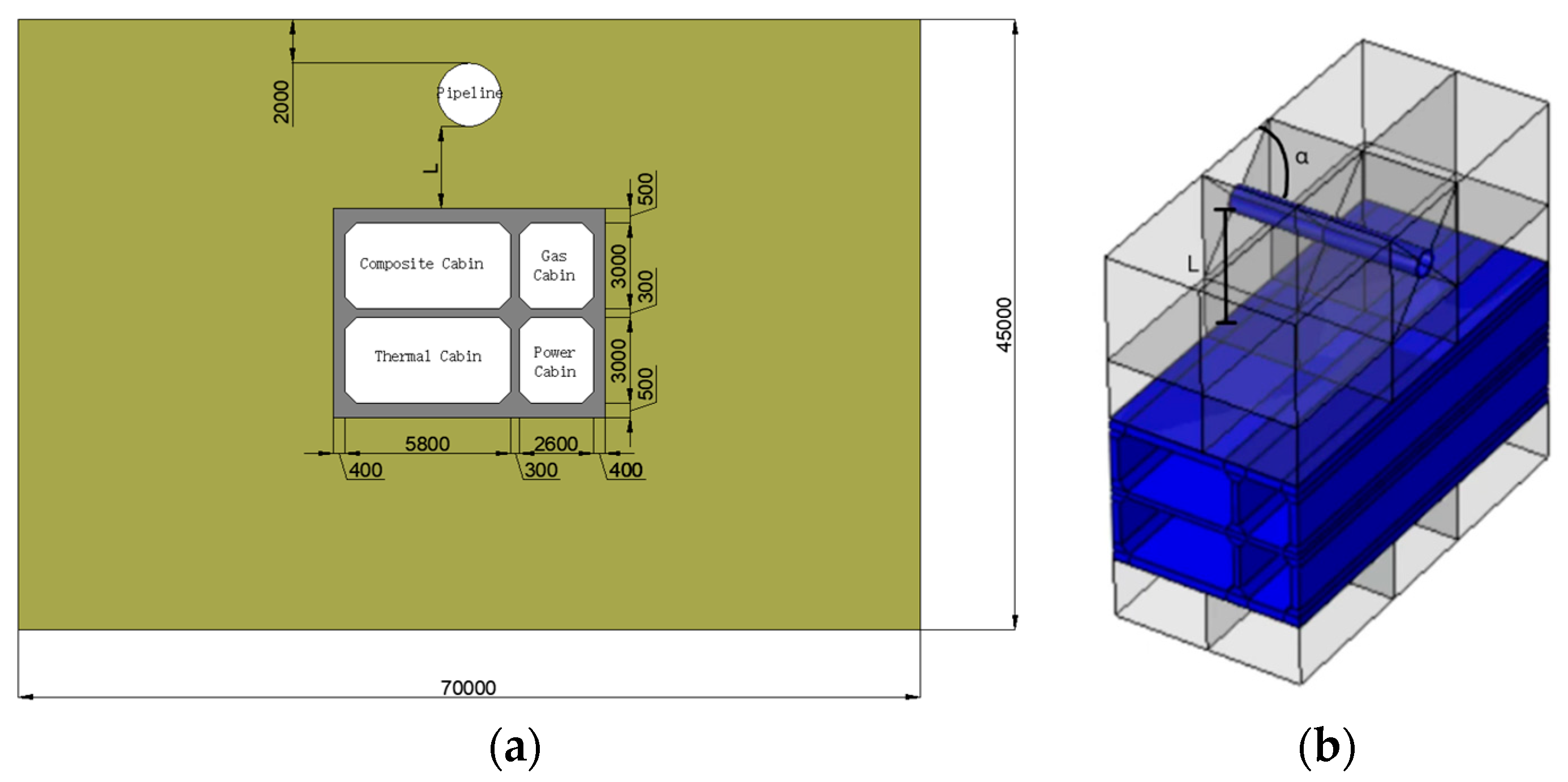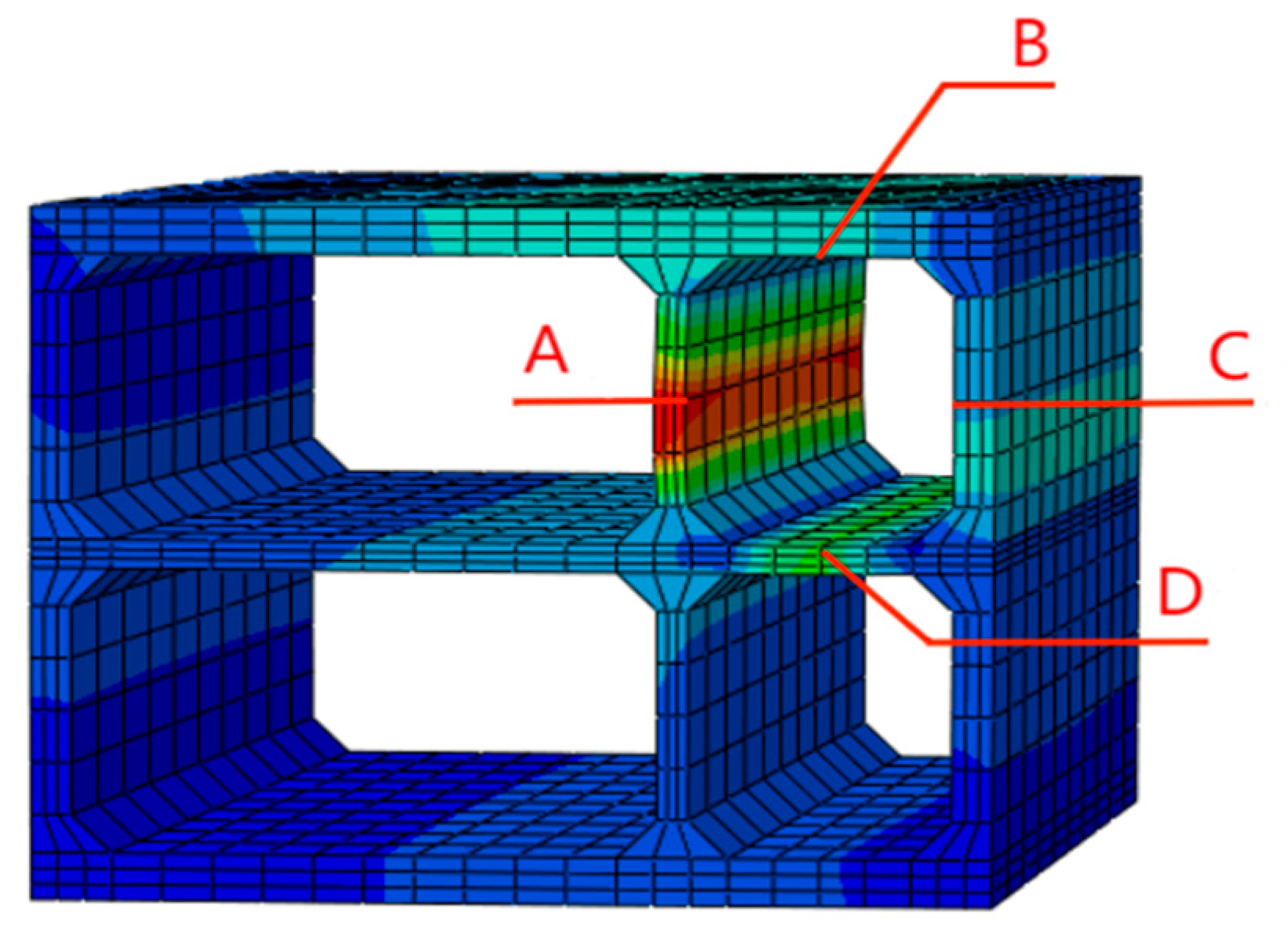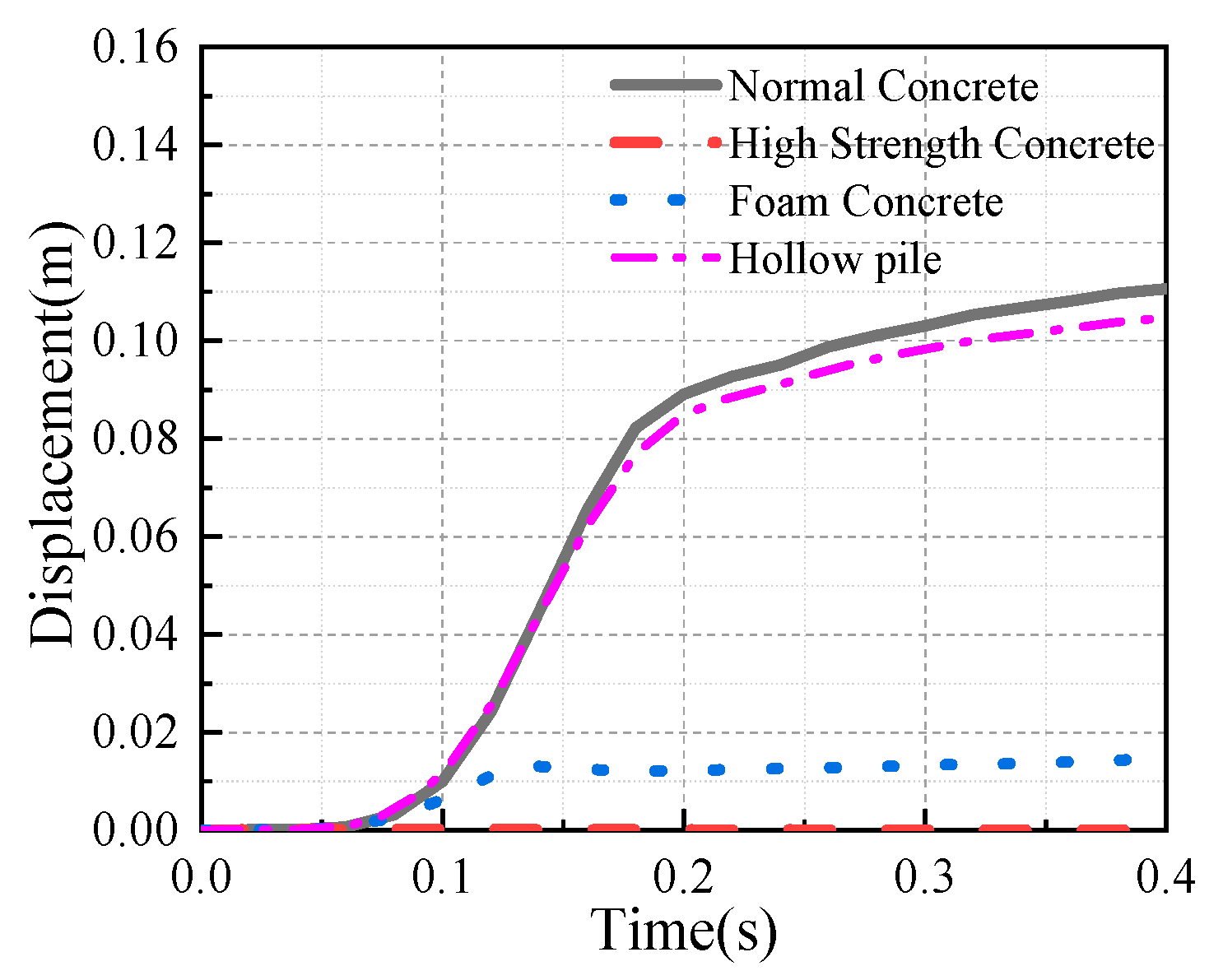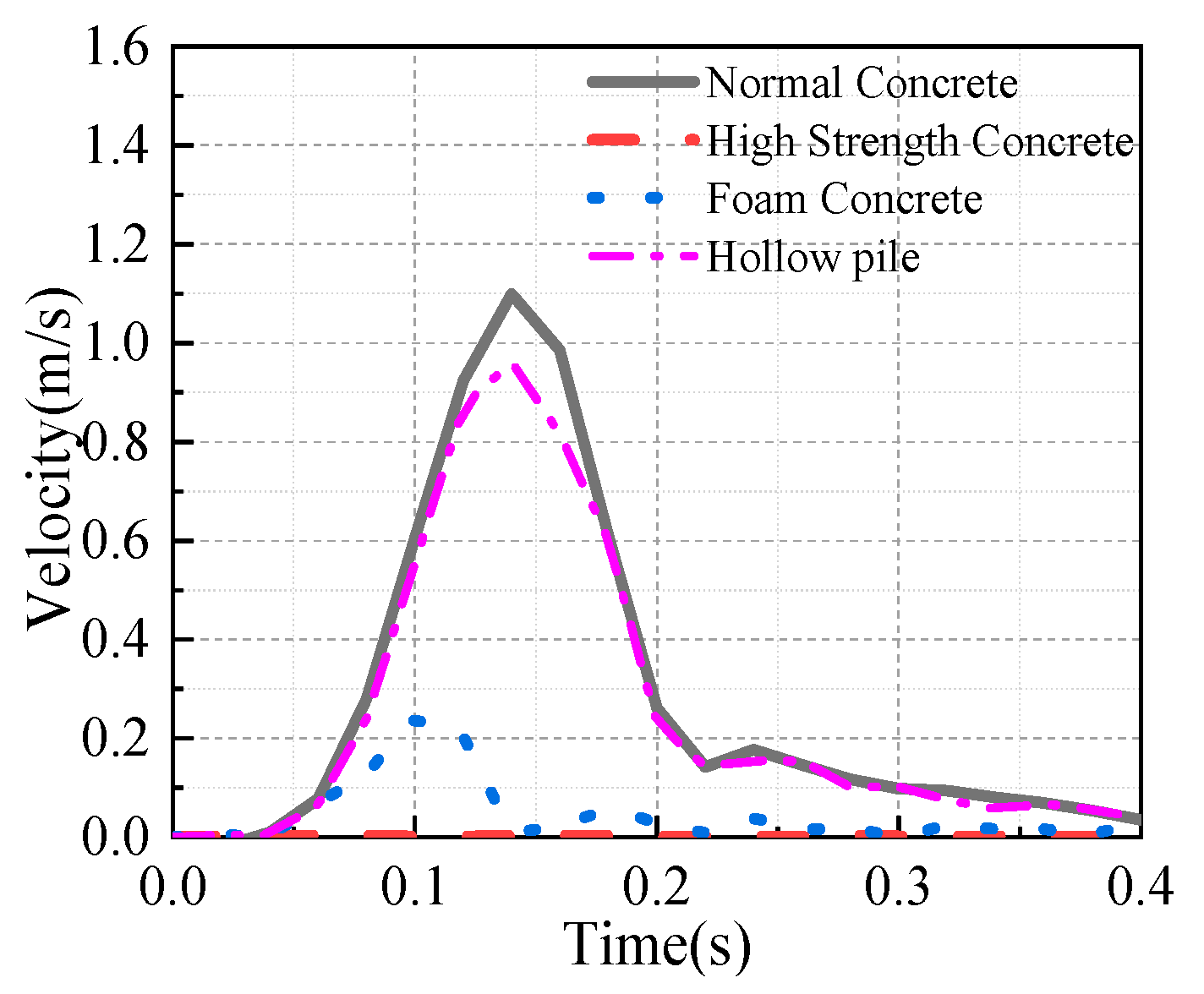Influence of Gas Explosions in Utility Tunnels on the Structural Safety of Overhead Pipelines
Abstract
1. Introduction
2. Computational Model
3. Gas Explosion Load
4. Numerical Simulation
4.1. The Impact of Gas Explosions on Utility Tunnels
4.2. The Impact of Gas Explosions on Pipelines Under Different Angular Conditions
4.3. The Impact of Gas Explosions on Pipelines Under Different Spacing Conditions
4.4. The Impact of Protective Measures on Gas Explosions
5. Conclusions
- (1)
- Under the action of the gas explosion, the wall of the utility tunnel expands outward. Due to the constraint of the surrounding soil, the deformation of the left wall (unconstrained or weakly constrained side) of the utility tunnel is significantly greater than that of the right wall, and the displacement of the bottom plate is also much greater than that of the top plate. Analysis shows that the pipe wall area with the largest area affected by the explosion and the weakest soil constraint is the most vulnerable weak link in the utility tunnel structure. Therefore, in the blast-resistant design of pipe galleries, special attention should be paid to strengthening these weak areas.
- (2)
- The damage to the overhead pipelines decreases as the angle between the pipelines and the utility tunnel increases. The diameter deformation rate when they are perpendicular is only 49% of that when they are parallel. Therefore, when arranging the pipelines, they should be made as perpendicular to the gas chamber as possible to reduce the length of the pipelines affected by the gas chamber, thereby minimizing the damage caused by gas explosions.
- (3)
- The stress, diameter deformation rate, and displacement of the pipelines all decrease as the distance between the pipelines and the utility tunnel increases. Moreover, increasing the distance within 3 m can significantly reduce the damage to the pipelines caused by gas explosions. However, the pipeline displacement is not sensitive to further increases in the distance beyond 3 m. Therefore, it is recommended that the distance between the pipelines and the utility tunnel be set at 3 m.
- (4)
- The methods of strengthening the gas chamber and using energy-absorbing materials can both effectively reduce the displacement and velocity of the overhead pipelines. Arranging hollow piles can also play a certain protective role. These strengthening methods can be considered for use when it is impossible to increase the angle and the distance between the pipelines and the utility tunnel.
- (5)
- This study provides a theoretical basis and practical suggestions for the blast-resistant design of underground utility tunnel systems. Future research could further explore the effects of different parameters on explosions and the application of new high-performance protective materials.
Author Contributions
Funding
Data Availability Statement
Conflicts of Interest
References
- You, X.H. State-of-art and prospectives of urban utility tunnels in China. Tunn. Constr. 2018, 38, 1603–1611. [Google Scholar]
- Dai, C.; Zhang, P.L.; Zhong, C.J. Discussion on engineering application and design scheme of double-deck utility tunnel. Water Wastewater Eng. 2018, 54, 109–113. [Google Scholar]
- Wang, F.B.; Wang, Y.; Wang, Z.M. Construction Technology of Multi-storey Utility tunnel in Xiong an. In Proceedings of the 26th Civil Engineering Construction Technology Exchange Meeting of Six Provinces and One City in East China (Volume I), Hangzhou, China, 21–23 October 2020; pp. 198–200. [Google Scholar]
- Zhang, Z.C. Research on Management and Development of Urban Underground Pipeline Galleries at Home and Abroad. Constr. Sci. Technol. 2018, 24, 42–52+59. [Google Scholar]
- Li, Z.; Chen, L.; Yan, H.C. Gas explosions of methane-air mixtures in a large-scale tube. Fuel 2021, 285, 119239. [Google Scholar] [CrossRef]
- Tian, S.Y.; Liu, J.; Gao, K. Experimental study on shock wave impulse and pressure rise rate of gas explosion in airtight pipeline. J. Saf. Sci. Technol. 2015, 11, 16–21. [Google Scholar]
- Shearer, M.J.; Tam, V.H.Y.; Corr, B. Analysis of results from large scale hydrocarbon gas explosions. J. Loss Prev. Process Ind. 2000, 13, 167–173. [Google Scholar] [CrossRef]
- Ajrash, M.J.; Zanganeh, J.; Moghtaderi, B. Flame deflagration in side-on vented detonation tubes: A large scale study. J. Hazard. Mater. 2018, 345, 38–47. [Google Scholar] [CrossRef]
- Wu, J.S.; Cai, J.T.; Zhao, Y.M.; Cao, Y.; Zhou, R.; Pang, L. Experimental study of the propagation characteristics of gas explosions in urban utility tunnels. J. Tsinghua Univ. Sci. Technol. 2022, 62, 987–993. [Google Scholar]
- Yan, Q.S.; Zhang, Y.A. Characteristic Study on Gas Blast Loadings in an Urban Utility Tunnel. J. Perform. Constr. Facil. 2020, 34, 04020076. [Google Scholar] [CrossRef]
- Yan, Q.S.; Zhang, Y.N.; Li, S.T. Experimental study and numerical simulation of gas explosion load characteristics in utility tunnel. Blasting 2021, 38, 140–146. [Google Scholar]
- Cao, J.; Wu, J.; Zhang, H.; Cai, J.; Wang, Y.; Fan, C. Experimental study on hydrogen-blended natural gas explosion characteristic and severity control measure in utility tunnels. Int. J. Hydrogen Energy 2024, 92, 738–747. [Google Scholar] [CrossRef]
- Chen, D.; Zhang, H.; Li, J.; Liu, K.; Wang, Y.; Huang, Y.; Mao, Z.; Wu, C. A full-scale experimental investigation of natural gas explosion in a 710-m long utility tunnel with multiple pipelines. Tunn. Undergr. Space Technol. 2024, 153, 106049. [Google Scholar] [CrossRef]
- Duan, Y.; Liu, L.; Yang, J.; Long, J.; He, G.; Lei, S.; Duan, X. Effects of explosion-venting interlayer within utility tunnels on the characteristics of natural gas explosions. Fuel 2024, 377, 132766. [Google Scholar] [CrossRef]
- Liu, Z.X.; Wang, Z.K.; Zhang, H.H.; Xu, H. Numerical Simulation of Blast-resistant Performance of Utility Tunnel under Gas Explosion. J. Disaster Prev. Mitig. Eng. 2018, 38, 624–632. [Google Scholar]
- Zhang, K.M. Study on Structural Dynamic Response and Damage Laws of Under Gas Explosion in Underground Utility Tunnel. Master’s Thesis, Beijing University of Civil Engineering and Architecture, Beijing, China, 2020. [Google Scholar]
- Shi, Y.C. Dynamic Response and Damage Mechanism of Reinforced Concrete Structures Under Blast Loading. Ph.D. Thesis, Tianjin University, Tianjing, China, 2010. [Google Scholar]
- Wang, Q. Numerical Analysis for Progressive Collapse and Protection of Underground Structure Under Internal Blast Load. Master’s Thesis, Tianjin University, Tianjing, China, 2014. [Google Scholar]
- Feng, X.H. Study on Mechanism and Mode of Progressive Collapse of Underground Structure Subjected to Its Internal Blast Loading. Master’s Thesis, Tianjin University, Tianjing, Chian, 2011. [Google Scholar]
- Zhou, Q.; He, H.G. Evaluation of blast-resistant ability of shallow-buried reinforced concrete urban utility tunnel. Eng. Fail. Anal. 2021, 119, 105003. [Google Scholar] [CrossRef]
- Wang, S.P.; Li, Z. Performance of utility tunnels under gas explosion loads. Tunn. Undergr. Space Technol. Inc. Trenchless Technol. Res. 2020, 109, 103762. [Google Scholar] [CrossRef]
- Tian, W.; Wu, Z.Y.; Wang, Y.W.; Xiao, Y.Q.; Zhang, X.D. Dynamic response law of structure under explosion in gas cabin of underground integrated utility tunnel. Sci. Technol. Eng. 2019, 19, 31–36. [Google Scholar]
- Xia, M.; Wang, J.H.; Liu, F. Numerical simulation study on dynamic response of utility tunnel structure under shallow-buried explosion. Prot. Eng. 2020, 42, 25–32. [Google Scholar]
- Xu, Y.; Huang, Y.M.; Li, J.; Ma, G. A risk-based optimal pressure relief opening design for gas explosions in underground utility tunnels. Tunn. Undergr. Space Technol. Inc. Trenchless Technol. Res. 2021, 116, 104091. [Google Scholar] [CrossRef]
- Xue, Y.Z.; Chen, G.H.; Zhang, Q.; Xie, M.; Ma, J. Simulation of the dynamic response of an urban utility tunnel under a natural gas explosion. Tunn. Undergr. Space Technol. Inc. Trenchless Technol. Res. 2021, 108, 103713. [Google Scholar] [CrossRef]
- Gao, X.J.; Zhou, J.; Zhang, Y.; Lv, J.J.; Liu, N. Study on blast resistance performance and reinforcement method of underground utility tunnel. Eng. Bl. 2023, 29, 145–151+158. [Google Scholar]
- Wu, J.; Zhao, Y.; Zhou, R.; Cai, J.; Pang, L. Suppression effect of porous media on natural gas explosion in utility tunnels. Fire Saf. J. Prepubl. 2022, 128, 103522. [Google Scholar] [CrossRef]
- Wang, H.N. Study on the Influence of Propagation Law Gas Explosion in Underground Utility Tunnel with Porous Structure. Master’s Thesis, Beijing University of Civil Engineering and Architecture, Beijing, China, 2024. [Google Scholar]
- Pang, L.; Li, W.; Yang, K. Gas explosion overpressure loads in utility tunnels under different pipe support spacing. Tunn. Undergr. Space Technol. Inc. Trenchless Technol. Res. 2025, 155, 106193. [Google Scholar]
- Zhang, H.; Wu, J.; Cao, J.; Fan, C.; Cai, J.; Wang, Y. Effects of hydrogen status and compartment structure on hydrogen explosion propagation in utility tunnels. Int. J. Hydrogen Energy. 2024, 96, 652–663. [Google Scholar] [CrossRef]
- Xia, Z.; Li, H.; Xie, J.; Zong, Z.; Zhang, Z. Numerical study on dynamic response of a novel ribbed thin-walled UHPC box-type utility tunnel under gas explosion. Case Stud. Constr. Mater. 2024, 21, e03630. [Google Scholar]
- Cai, L.J.; Zhu, F.M.; Wu, L.; Han, F.; Peng, S. Influence of Accidental Explosion of Upper Highway Tunnel on the Lower Water Supply Tunnel. Chin. J. Undergr. Space Eng. 2013, 9, 1197–1200. [Google Scholar]
- De, A.; Zimmie, T.F. Effects of Surface Explosion on Underground Tunnel and Potential Mitigation Measures. Transp. Infrastruct. Geotech. 2016, 3, 74–90. [Google Scholar] [CrossRef]
- De, A.; Morgante, A.N.; Zimmie, T.F. Numerical and physical modeling of geofoam barriers as protection against effects of surface blast on underground tunnels. Geotext. Geomembr. 2016, 44, 1–12. [Google Scholar]
- Smith, P.D.; Vismeg, P.; Teo, L.C.; Tingey, L. Blast wave transmission along rough-walled tunnels. Int. J. Impact Eng. 2018, 21, 419–432. [Google Scholar]
- Schecklinski-Gluck, G.A. Calculation procedure for blast in tunnel branchings developed from experiments and AUTODYN calculations. In Proceedings of the 7th International Symposium Interaction of the Effects of Munitions with Structures, Mannheim, Germany, 6–10 April 2015. [Google Scholar]
- Copper, M. Experimental and numerical investigation of blast wave propagation in tunnels. In Proceedings of the 15th International Symposium on Military Aspects of Blast and Shock, Banff, AB, Canada, 11–15 September 2017. [Google Scholar]
- Bao, Q.; Fang, Q.; Zhang, Y.; Chen, L.; Yang, S.; Li, Z. Effects of gas concentration and venting pressure on overpressure transients during vented explosion of methane-air mixtures. Fuel 2016, 175, 40–48. [Google Scholar] [CrossRef]
- Liu, H.B. Dynamic Analysis of Subway Structures Under Blast Loading. Geotech. Geol. Eng. 2009, 6, 699–711. [Google Scholar] [CrossRef]
- Wang, P.F. Study on Influence of Gas Explosion on Utility Tunnel and Adjacent Subway Tunnel. Master’s Thesis, Xi’an Technological University, Xi’an, China, 2022. [Google Scholar]
- Wang, D.; Chen, C.H.; Zhang, H.; Liu, Z.X.; Meng, S.B. Influence of gas explosion in a utility tunnel on the structural safety of a undercrossing tunnel. J. Vib. Shock 2023, 42, 160–166+185. [Google Scholar]
- GB 50253—2014; Code for Design of Oil Transportation Pipeline Engineering. Planning Press: Beijing, China, 2014.
- GB 50157—2013; Code for Design of Metro. China Architecture & Building Press: Beijing, China, 2013.













| Material Type | Density/(kg/m3) | Elastic Modulus/GPa | Poisson’s Ratio |
|---|---|---|---|
| C30 concrete | 2400 | 30 | 0.2 |
| C45 concrete | 2450 | 33.5 | 0.2 |
| High-performance concrete | 2400 | 53 | 0.2 |
| Foam concrete | 800 | 3.8 | 0.21 |
| C80 concrete | 2488 | 37 | 0.26 |
| Steel | 7800 | 200 | 0.30 |
| Soil | 2200 | 0.03 | 0.35 |
Disclaimer/Publisher’s Note: The statements, opinions and data contained in all publications are solely those of the individual author(s) and contributor(s) and not of MDPI and/or the editor(s). MDPI and/or the editor(s) disclaim responsibility for any injury to people or property resulting from any ideas, methods, instructions or products referred to in the content. |
© 2025 by the authors. Licensee MDPI, Basel, Switzerland. This article is an open access article distributed under the terms and conditions of the Creative Commons Attribution (CC BY) license (https://creativecommons.org/licenses/by/4.0/).
Share and Cite
Wang, D.; Dong, J.; Chen, X.; Du, J.; Shu, D.; Krassowska, J. Influence of Gas Explosions in Utility Tunnels on the Structural Safety of Overhead Pipelines. Buildings 2025, 15, 3391. https://doi.org/10.3390/buildings15183391
Wang D, Dong J, Chen X, Du J, Shu D, Krassowska J. Influence of Gas Explosions in Utility Tunnels on the Structural Safety of Overhead Pipelines. Buildings. 2025; 15(18):3391. https://doi.org/10.3390/buildings15183391
Chicago/Turabian StyleWang, Dai, Jian Dong, Xuan Chen, Jianmei Du, Dawei Shu, and Julita Krassowska. 2025. "Influence of Gas Explosions in Utility Tunnels on the Structural Safety of Overhead Pipelines" Buildings 15, no. 18: 3391. https://doi.org/10.3390/buildings15183391
APA StyleWang, D., Dong, J., Chen, X., Du, J., Shu, D., & Krassowska, J. (2025). Influence of Gas Explosions in Utility Tunnels on the Structural Safety of Overhead Pipelines. Buildings, 15(18), 3391. https://doi.org/10.3390/buildings15183391






